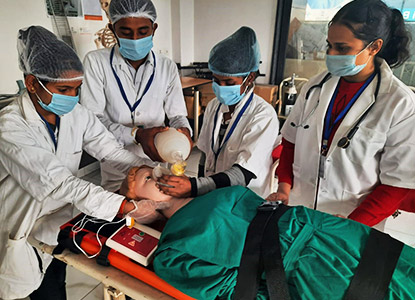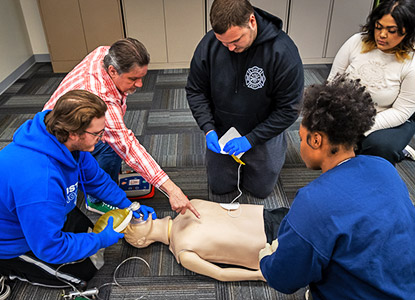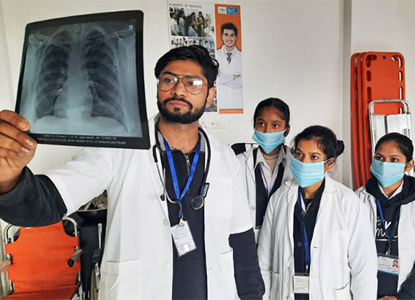
The Emergency Medical Technician (EMT) course is a great option for students who are interested in entering the healthcare field with a practical, high-demand job. This course prepares individuals to provide immediate medical care to patients in critical situations, ensuring their safety and stabilizing them until they can receive further treatment at a hospital or medical facility.
Eligibility Requirements for the Emergency Medical Technician Course
Undergraduate (UG) Requirements:
-
Candidates must have completed their 12th grade with Biology, Chemistry, and Physics as core subjects.
-
An overall score of at least 50% is generally required.
-
Some institutes also accept candidates with Botany, Computer Science, Biochemistry, or Zoology as their core subjects.
Postgraduate (PG) Requirements:
-
Candidates wishing to pursue a Postgraduate (PG) program in Emergency Medical Technology should have completed their graduation in a related discipline, typically with a cumulative score of at least 55%.
Necessary Skill Set for Emergency Medical Technology
Emergency Medical Technicians (EMTs) play a crucial role in healthcare, especially in emergency scenarios. They need to have a wide range of skills, including:
-
Quick decision-making: Ability to assess and act under pressure.
-
Multitasking: Handling multiple tasks efficiently in a chaotic environment.
-
Adaptability: Comfort with unpredictable schedules and varying patient conditions.
-
Calmness under stress: Remaining composed in high-pressure situations.
-
Attention to detail: Critical when providing care and handling equipment.
-
Good communication skills: Interacting effectively with patients, families, and medical teams.
-
Teamwork: Ability to work collaboratively or lead a team during emergencies.
-
Self-reliance: Having the confidence to take initiative when needed.
Objectives of the EMT Course
Upon completing the Emergency Medical Technician course, students will be able to:
-
Understand the EMS System: Learn about the essential components of the Emergency Medical Services (EMS) system and how it operates.
-
Perform CPR: Administer Cardiopulmonary Resuscitation (CPR) for adults, children, and infants in emergency situations.
-
Basic Airway Management: Learn techniques for managing airways and performing different airway maneuvers.
-
Medical Emergency Assessment: Understand how to assess and treat medical and traumatic emergencies, including recognition of signs of various conditions.
-
Use of AED: Learn how to use Automated External Defibrillators (AEDs) effectively during emergencies.
-
Patient Transfer and Emergency Moves: Learn how to transfer patients safely and perform emergency moves.
Course Description
The Emergency Medical Technician (EMT) course covers both theoretical knowledge and hands-on practical experience. Key areas of learning include:
-
Anatomy and Physiology: Understanding the human bodys structure and functions.
-
Patient Assessment: Learning how to conduct thorough assessments, including taking patient history and monitoring vital signs.
-
CPR and BLS: Mastering the techniques of Cardiopulmonary Resuscitation (CPR) and Basic Life Support (BLS).
-
EMS System: Gaining an understanding of how the Emergency Medical Services (EMS) system operates, including various components like ambulance services, paramedics, and hospitals.
-
Airway Management: Learning techniques to maintain open airways and using equipment like bag-valve masks.
-
Trauma and Medical Emergencies: Recognizing and managing trauma-related injuries such as head, neck, spine, abdominal, thoracic, and soft tissue injuries.
-
Shock Management: Identifying the signs of shock and providing the necessary treatment.
-
Environmental and Geriatric Emergencies: Learning how to treat emergencies caused by environmental factors (e.g., hypothermia, heatstroke) and medical concerns in elderly patients.
-
Pediatric and Obstetric Emergencies: Focusing on emergency care for children and pregnant women.
-
Movement and Patient Transfer: Mastering safe techniques to move and transfer patients, including those in critical conditions.
Course Highlights
-
Duration: Typically 1 to 1.5 years.
-
Certification: Upon successful completion, students receive a certification that qualifies them as Emergency Medical Technicians.
-
Practical Training: Hands-on experience in hospital and emergency care settings.
-
Eligibility: Open to students who have completed their 12th grade with a science background.
-
Job Opportunities: EMTs are in high demand across hospitals, ambulatory services, emergency medical response teams, and disaster relief teams.
-
Career Growth: With experience, EMTs can advance to paramedics, or other specialized emergency roles.
Scope and Career Opportunities
The Emergency Medical Technician field is one of the best job-oriented courses after 12th, especially for students interested in healthcare but looking for quicker entry into the workforce. EMTs are crucial for saving lives and providing immediate medical care in emergency situations.
-
Hospitals: EMTs often work in emergency departments, where they assist doctors and nurses in urgent medical cases.
-
Ambulance Services: They serve on ambulances, providing critical care during transport to healthcare facilities.
-
Disaster Relief: EMTs are often part of disaster response teams, helping in situations like natural disasters, accidents, or mass casualties.
-
Private Clinics and Organizations: Many private clinics or organizations hire EMTs for handling emergency care or as part of a medical response team.
- Job Security and Pay: With increasing demand for trained EMTs worldwide, the career offers good salary prospects and job stability.

























